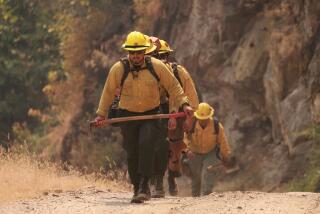Explorer Scouts Find Action of a Different Sort Near Fire Lines
The Explorer Scout program of the Los Angeles Fire Department has given Phil Fligiel a view of life unseen by most Chatsworth 17-year-olds.
“I’ve seen people die right in front of me,” said Fligiel, who helps fight fires in downtown and South-Central Los Angeles.
“I’m constantly seeing shootings and gang fights and stuff like that,” he said. “But I’ve seen them now, and I’m used to it.”
Fligiel, a senior at Chatsworth High School, has spent more than 2,500 hours riding with city firefighters during his two years in Explorer Scout Post 100 at the Van Nuys fire station.
The Explorer Scout program of the Boy Scouts of America provides career information and experience for young men and women 15 to 21, including first-hand observation of professions like police work and firefighting.
‘Hands-On Experience’
The program “gives kids in specific areas hands-on experience right now,” said Tommy Miles, senior Explorer executive with the Western Los Angeles County Council of the Boy Scouts of America. Applicants need not be Boy Scouts, he said.
To become a Fire Explorer Scout, applicants must pass physical agility and oral tests and take six months of firefighting training. They learn fire chemistry, hose handling and stretcher carrying, and how to operate generators, lights and smoke-clearing fans.
Once a Scout is certified to accompany working firefighters, he can request permission from his adviser to ride with any engine company in the city for a 12-hour period or a full 24-hour shift.
Explorers experience fire station life and ride on emergency calls. At fires, Explorers have such tasks as checking to see that hoses are properly connected, guarding against theft and vandalism, setting up lights and fans, cleaning up after the fire and driving small trucks and cars on errands, said Jim Carson, firefighter and Explorer adviser.
“They can do everything but what they want to do, which is to get in there and fight fires,” he said.
Scouts are always strictly supervised on emergency calls, he said. “When an Explorer goes out on an engine or truck company, there’s a captain there who knows what level of experience this individual has, and he can direct him,” Carson said.
No Hazardous Activity
Los Angeles City Battalion Chief Melvin Leydecker, the coordinator of the program since it began 10 years ago, said the Explorers “are not exposed to any hazardous activity.
“They are not firefighters. They do not replace firefighters,” he said.
Leydecker said two Explorers suffered minor injuries since the program began and both remained in the program.
There are about 100 Explorer Scouts and 11 participating fire stations throughout the city, four of them in the San Fernando Valley--Northridge Station 70, Sepulveda Station 88, Van Nuys Station 100, and North Hollywood Station 86. The Van Nuys station’s program is full, Carson said, but there are openings at other stations.
Fligiel said he heard about the Explorer program from a firefighter friend.
“It’s always fascinated me--these people going out and risking their lives,” he said. “When I first got ride-along certified, I rode out every other day in the summertime.”
Carson described Fligiel as an example of the leadership skills the program aims at developing.
“Phil has turned himself into a strong, confident, committed adult,” Carson said. “In a way it’s a shame the poor kid is only 17 years old. He probably knows a lot more than rookies on the job.”
Scouts also can ride with paramedics, the emergency medical arm of the Fire Department. They must spend at least 500 hours riding with firefighters and earn an Emergency Medical Technician certificate in a course taught by the Fire Department or a hospital before they can help treat patients, Carson said.
Paramedic Explorers are allowed to help with such tasks as applying simple bandages, monitoring instruments and holding intravenous fluid containers.
Career Goal
Christi Martin, 19, of Woodland Hills is one of five Scouts at Post 100 certified to ride with paramedics and intends to make it her career.
Carson said that when Martin began the program “she didn’t have any medical background. She was a lifeguard and was in school and working someplace else. Now, she’s doing all the things necessary to prepare her for a job.”
Martin is the only female among the 17 Explorer Scouts of Post 100. Very few females join the Explorer program, Carson said. The post, which once had three female Scouts, is trying to recruit more young women.
‘Opportunity to Explore’
Not all the Scouts intend to become firefighters or paramedics, Carson said. “They don’t necessarily have to have that as a direction. They may really be looking for an opportunity to--just as the word says--explore.”
The experience “is not designed to be a steppingstone to getting a job,” Leydecker said. “It’s set up for young people to look at a career.”
However, Fligiel has no doubt that he wants to be a firefighter.
“If all works out well, I’ll be 18 and I’ll have a job,” Fligiel said. He said he would like to work at Fire Station 33 in South-Central Los Angeles where he has had most of his training “because they’re the busiest task force in the city.”
His father approves of his decision to join the Fire Department, Fligiel said, but his mother worries. “Every time she sees something on the news . . . she says, ‘Are you sure you want to do this?’ ”
More to Read
Sign up for Essential California
The most important California stories and recommendations in your inbox every morning.
You may occasionally receive promotional content from the Los Angeles Times.









